After 1992 the NFL (who backed the WLAF)
suspended operations. When the WLAF returned in the 1995 season the league was concentrated in Europe, and none of the seven
North American teams (including New York-New Jersey Knights) were ever heard of again.
They played their
home games at Giants Stadium, also home to the NFL's New York Giants and New York Jets.
Darrel "Mouse" Davis (born September
6, 1932) is a veteran high school, college, and professional football coach. A native of Washington, he grew
up in Oregon where he started his coaching career as a high school football coach. He helped to popularize the use of the
Run & Shoot offense.
Early life
Darrel Davis
was born in Eastern Washington in Palouse on September 6, 1932. His family later moved to neighboring Oregon and Davis lists
Independence, Oregon, as his hometown. Mouse gained his nickname from older brother Don while a freshman shortstop on the
Central High School team in neighboring Monmouth, Oregon. Despite his 4’10” (1.47 m) stature at the time, Mouse
already excelled at sports. In 1955, he graduated from the Oregon College of Education (now Western Oregon University) in
neighboring Monmouth. There he played quarterback and halfback on three straight championship teams from 1952–54 under
Coach Bill McArthur. Davis also played basketball and baseball at the college.
Coaching
Davis helped make the Run & Shoot offense famous as a coach, revolutionizing football back in the 1960s
and 1970s. In developing his Run & Shoot offense, Davis espoused the theories of Middletown (Ohio) High School coach Glenn
"Tiger" Ellison, who wrote the book Run & Shoot Football: Offense of the Future. Davis utilized the
offense in a coaching career that included 15 years at the high school level in Oregon, at the college level, and professionally
in the NFL, CFL, USFL, WLAF, and Arena League.
High school
Davis
spent 15 seasons coaching high school football in Oregon, culminating in a 1973 state championship at Hillsboro High School.
That team went 11-1 and set school marks in seven team season offensive categories and 15 records overall. Davis also was
head coach at Sunset and Milwaukie high schools in Oregon, building a combined 79-29 record among those three schools.
College
Mouse Davis then moved on to take the head coaching
position at Portland State University, where he coached from 1975 to 1980. While at Portland State from 1975 to 1980, and
at each of his subsequent stops, he helped popularized the "Run & Shoot" offense.
There
he led the PSU football program to a 42-24 record over six seasons, averaged 38 points and nearly 500 yards of offense per
game. PSU led the nation in scoring three times. The unique passing game made stars out of Davis’ two main quarterbacks,
June Jones and Neil Lomax. In 1975, Jones, now the current Southern Methodist University and former University of Hawaiʻi head coach, threw
for a Division II - record 3,518 yards. Davis' next quarterback, Lomax, set NCAA records of 13,220 yards and 106 touchdowns
in 42 games. Under Davis' direction, Portland State set 20 NCAA Division II offensive records[1] in addition to the Vikings being named the NCAA's all-time point producers
in 1980, scoring 541 points in 11 games for 49.2 points per game, along with 434.9 yards passing and 504.3 yards of total
offense per game. After coaching at Portland State, Davis went on to coach at UC Berkeley.
The past three seasons, Davis served as an assistant coach for Jones at Hawaiʻi. The Warriors employed the Run & Shoot offense
and averaged 559.2 yards of total offense, 46.9 points and produced a 10-3 record in 2006. Hawaiʻi led the nation in passing offense (441.3), total offense,
scoring offense and pass efficiency (185.95). Then in February 2007, he returned to Portland State to serve as offensive coordinator
for new PSU head coach Jerry Glanville's staff. He retired at the age of 76 on June 1, 2009.
Davis was
an inaugural member of the Portland State Athletics Hall of Fame when he was inducted in 1997.
Professional
Davis has been head coach of the now-defunct USFL's Denver Gold,
the WLAF's New York/New Jersey Knights, and the Arena Football League's Detroit Furyand the af2's San Diego Riptide. He was
also an assistant coach with the NFL's Atlanta Falcons and Detroit Lions and with the Toronto Argonauts in the Canadian Football
League.
In 1982, Davis joined the Toronto Argonauts as offensive coordinator and turned the team into
a contender instantly with his pass-happy club. Led by his tandem of QBs Condredge Holloway (Tennessee) and Joe Barnes (Texas
Tech). They finished the regular season with a record of (9-6-1) Davis' Argos lost in the 70th Grey Cup in 1982 to the Warren
Moon-led Edmonton Eskimos to the score of 32-16.
Davis left the Argonauts prior to the 1983 season, however
the team, using the offense he had installed, finished the regular season with a commanding (12-4) record and did win the
71st Grey Cup that year over the British Columbia Lions to the score of 18-17. It was their first championship in 31 years.
In 1984, Davis headed back to the USA to take the offensive coordinator job with the USFL expansion Houston
Gamblers. His quarterback was a rookie from the University of Miami named Jim Kelly. The "Mouseketeers" offensive
unit lit up the USFL in their first year of existence passing for 5,793 yards and 45 passing touchdowns - ending their expansion
season with a (13-5) record. The Gamblers' offense became the first team in pro football history to have two receivers with
over 100 receptions in a single season (Richard Johnson - 115, Ricky Sanders - 101).
In 1985, Davis took
his first head coaching job at the professional level when he took the reins of the Denver Gold, bringing his run-and-shoot
offense to the Mile High City. He once again had a tandem of QBs in Vince Evans and Bob Gagliano. The Gold finished the season
with its first playoff berth with an (11-7) mark but lost in the first round to the Memphis Showboats.
1991
Davis took the head coaching job of the New York/New Jersey Knights of the WLAF. The 1991 season had Davis and the Knights
go (5-5) and won the North American East Division. But they bowed out of the playoffs semifinal to the eventual champion London
Monarchs. The following year saw their record improve to (6-4) and second place in the division but missed qualifying for
the playoffs.
wikipedia.org
| |
|
|
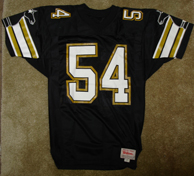
|
| 1991 Knights Home Jersey (gold outline) |
|
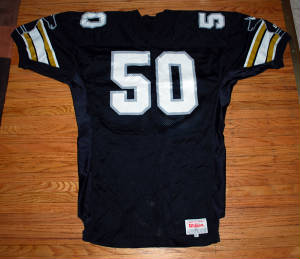
|
| 1992 Knights Home Jersey (silver outline) |
|
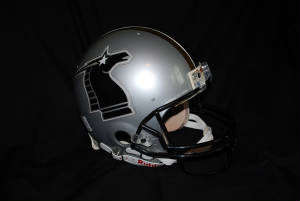
|
| Knights Helmet |
|
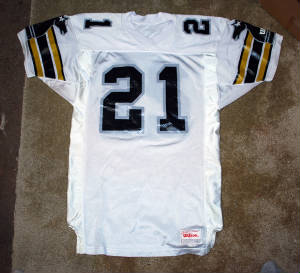
|
| Knight Away Jersey |
|
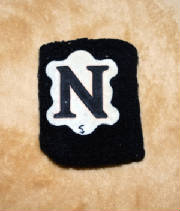
|
| Knights wristbands |
|
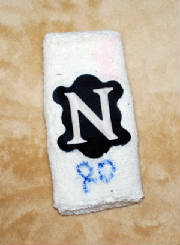
|
| Knights wristbands |
|
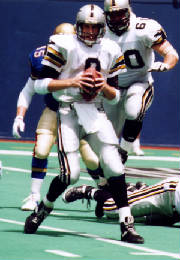
|
| Uniform in action |
|
|
|
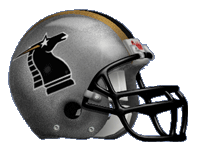
|
| 1991 Knights Results, Stats, Roster |
|

|
| 1992 Knights Results, Stats, Roster |
|